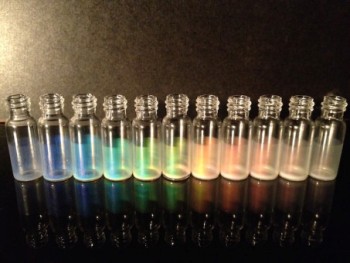Feb 26 2016
It has been estimated that 10% of the total energy utilized in buildings across the U.S. can be attributed to window performance, costing building owners around $50 billion every year, yet the increasing cost of retrofitting windows or replacing them with an energy efficient coating seem to be a major hindrance.
 Berkeley Lab’s paintable window coating is based on brush block copolymers that rapidly self-assemble to photonic crystals, which are easily tunable across the entire spectrum of solar energy. (Credit: Garret Miyake, University of Colorado)
Berkeley Lab’s paintable window coating is based on brush block copolymers that rapidly self-assemble to photonic crystals, which are easily tunable across the entire spectrum of solar energy. (Credit: Garret Miyake, University of Colorado)
Researchers at the Lawrence Berkeley National Laboratory (Berkeley Lab) of the U.S. Department of Energy (DOE) are currently working to address this issue with creative chemistry, which is a polymer heat-reflective coating that can be painted on at a fraction of the cost.
Instead of hiring expensive contractors, a homeowner could go to the local hardware store, buy the coating, and paint it on as a DIY retrofit—that’s the vision. The coating will selectively reflect the infrared solar energy back to the sky while allowing visible light to pass through, which will drastically improve the energy efficiency of windows, particularly in warm climates and southern climates, where a significant fraction of energy usage goes to air conditioning.
Raymond Weitekamp, Scientist, Berkeley Lab
A team of scientists from Berkeley Lab are receiving part of a $3.95 million award from the DOE’s Advanced Research Projects Agency–Energy (ARPA-E) to develop this new product. The multi-institutional team is headed by researcher Garret Miyake at the University of Colorado Boulder, and also includes Caltech and Materia.
A number of retrofit window films with spectral selectivity are commercially available, but they can only be installed with the help of a professional contractor, which is a barrier for several building owners. A cost-effective option could expand adoption and result in annual energy savings of 35 billion kilowatt-hours, reducing carbon dioxide emissions by 24 billion kilograms annually, the equivalent of removing 5 million cars off the road.
The Berkeley Lab technology relies on a material known as a bottlebrush polymer, which contains a single rigid chain of molecules along with bristles from the sides. This unique molecular architecture provides it with some exceptional properties, for instance it does not entangle easily.
Imagine spaghetti versus gummy worms. Spaghetti can be tied up in knots. If you want to rearrange cooked spaghetti back to its uncooked alignment, you would have to put significant energy into unwinding it. But with gummy worms you can line them all up easily because they’re pretty rigid.
Raymond Weitekamp, Scientist, Berkeley Lab
Weitekamp, a graduate student at Caltech, focused on understanding and monitoring how bottlebrush polymers self-assemble into nanostructures, acting as photonic crystals that can reflect light at varied frequencies. In 2015 Weitekamp visited the Berkeley Lab as part of Cyclotron Road, a program organized for entrepreneurial scientists, to commercialize all of these coatings including other related polymer-based technologies. Weitekamp has been researching the development of polymeric materials as a user at the Molecular Foundry, a DOE Office of Science User Facility at Berkeley Lab.
We were very compelled by the potential impact of [Weitekamp’s] technology across a number of industries. His ideas aligned with the Foundry’s expertise in polymer chemistry and the window application fit squarely into Berkeley Lab’s existing strengths in buildings technology and energy analysis.
Ilan Gur, Director, Cyclotron Road
For the ARPA-E award, Weitekamp is partnering with Berkeley Lab’s Steve Selkowitz, a chief expert on building science and window technologies, and Arman Shehabi, a specialist in examining energy use of buildings, to develop a scalable and cost-competitive product. Their target cost is $1.50 per square foot, one-tenth the current market cost for energy efficient retrofit window coatings that are commercially installed.
ARPA-E invests in high-risk, high-reward projects. The high reward in this project isn’t in the performance improvement. It’s transformative in how windows could be retrofitted—it’s something you can do yourself. The market need is very large, and there’s nothing low-cost out there that meets that need.
Arman Shehabi, Building Energy Use Expert
One prevailing technical challenge is to enhance the accuracy of the material so that the reflection of infrared light does not cause the visible light to become hazy or scattered. This allows the coating to reflect a huge amount of the sun’s energy, reducing the amount of heat passing through a building, while still being visible to the eye. Selkowitz will examine the coating’s performance using the cutting-edge windows testing facilities at Berkeley Lab.
We have a well-equipped optics lab where we can do detailed optical measurements of any coating on any glass substrate, looking at the optical and spectral properties, which can provide feedback to the chemical synthesis process. In the development phase, all that optical testing becomes a feedback loop to the chemistry. Additionally we can model and measure thermal comfort, which is important because what will motivate people to buy this coating is comfort in addition to energy savings.
Steve Selkowitz, Building Science Expert, Berkeley Lab
Shehabi plans to develop lifecycle assessment models and building simulation models to understand how this new technology would influence the usage of energy in buildings, and how to maximize energy savings. He will also be using technoeconomic models to observe things such as, payback period and manufacturing considerations.
We didn’t have any need to use particularly cost-effective materials and feedstocks when we were making this in the lab, but to scale this up, we’ll have to think through the technoeconomics. This was originally an exploratory synthetic chemistry project, but having the deep windows and building expertise on the applied side here at Berkeley Lab, we thought, we can do this in a bigger and better way.
Raymond Weitekamp, Scientist, Berkeley Lab